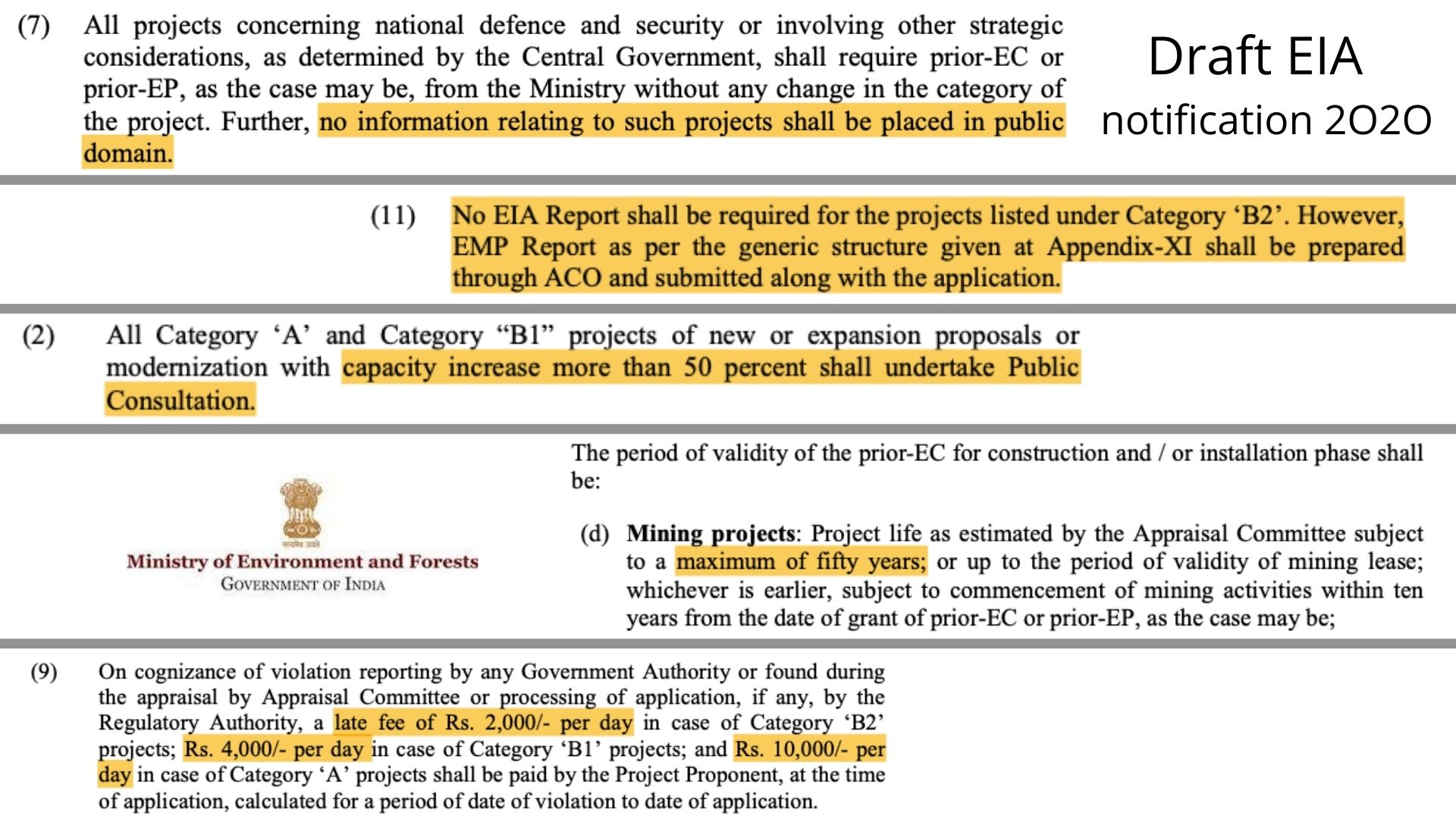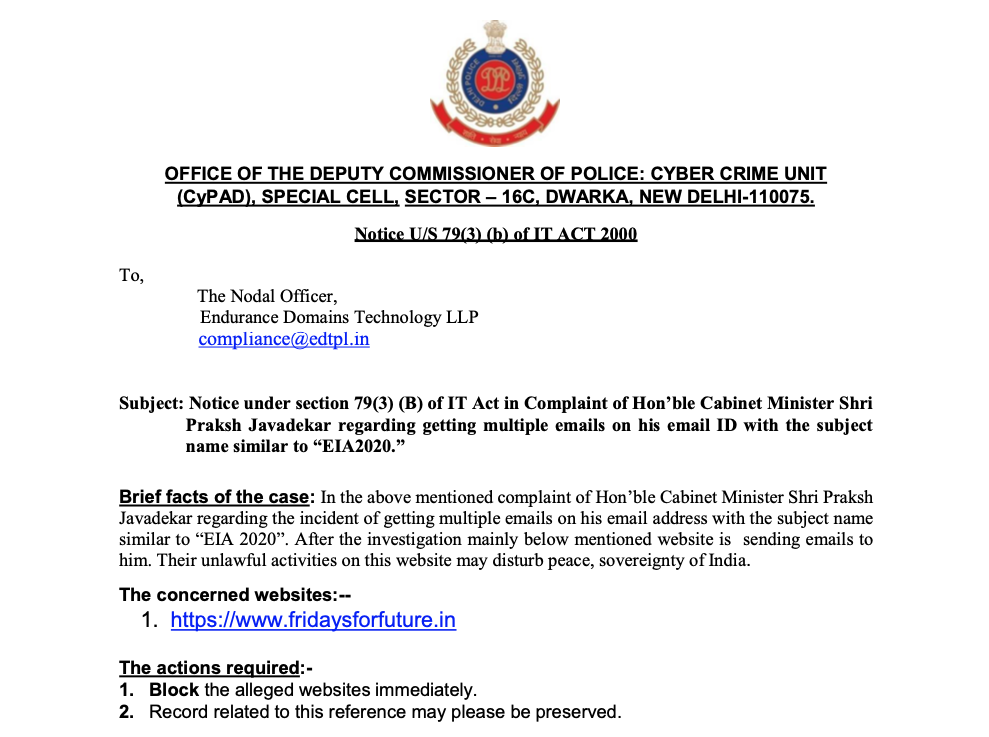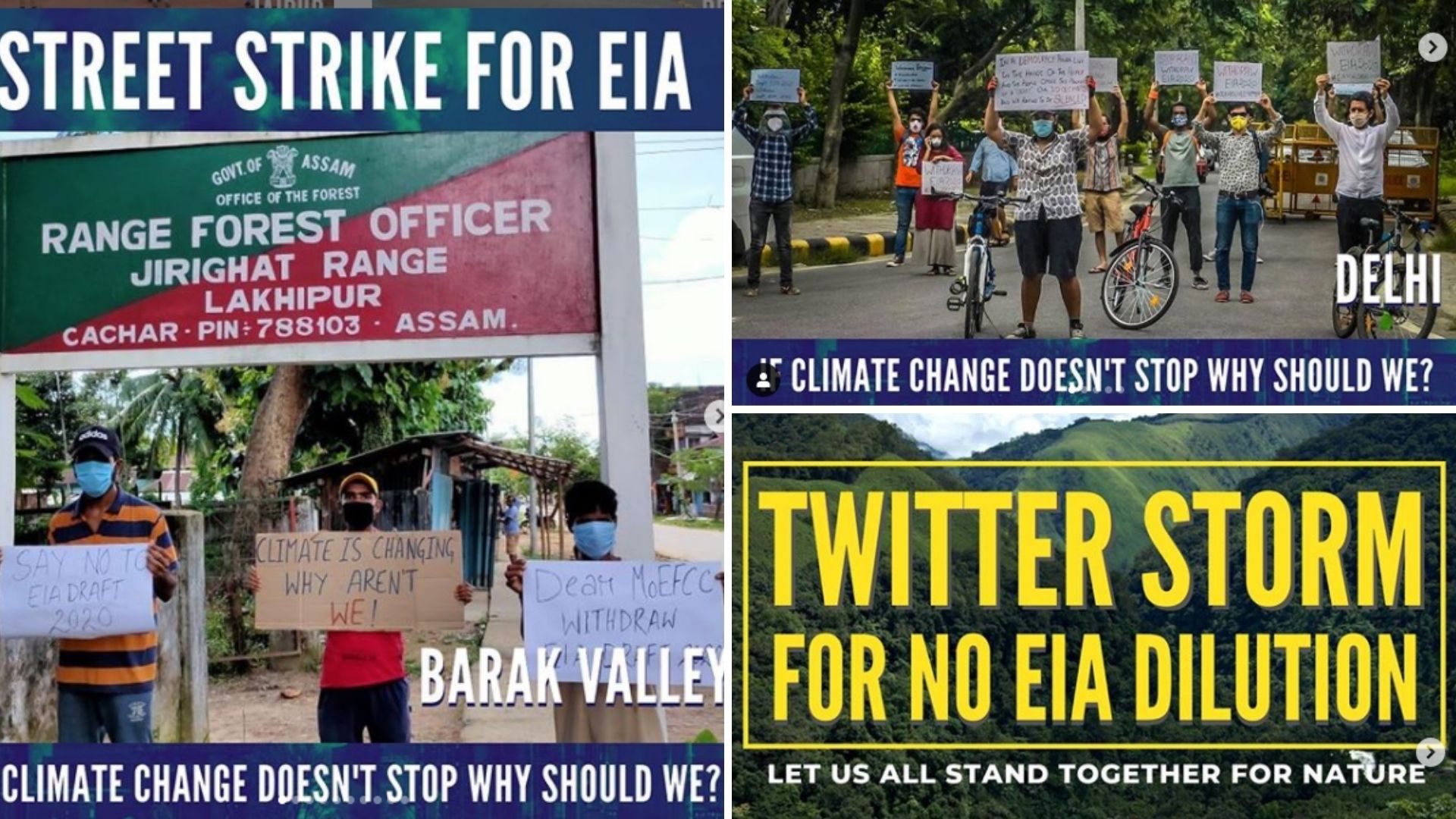The Environmental Impact Assessment (EIA) is defined as a tool used to “identify the environmental, social and economic impacts of a project prior to decision-making” by the United Nations Environment Programme (UNEP), the overall coordinating environmental organization of the United Nations (UN) system. Every country has its own adaptation of the EIA but they're required to adhere to certain fundamental guidelines set by the UN. However, the UNEP itself acknowledges that even with such impact assessment processes present in many countries, the natural resources still remain inadequately addressed.

Mr. Bittu Sahgal, the editor of Sanctuary Asia magazine and founder of the Sanctuary Nature Foundation tells The Outdoor Journal, “The EIA exists for good reason. That reason is that the economy is a wholly owned subsidiary of the environment. Therefore, protecting the environment is protecting the economy. You can not have a healthy economy if your environment is polluted and degraded. The impact on public health alone would be enormous, and the expense of addressing this colossal.”
India’s EIA came into effect in 1994 when it was born out of the Environment (Protection) Act 1983. The governments have made several alterations to the EIA since its inception (the last major one being in 2006). The Ministry of Environment, Forest and Climate Change, India issued a draft notification in March 2020, proposing major changes in India’s EIA, some of which are majorly skewed towards development and have received a massive outcry from activists and the public.

The new proposed changes claim to make the environment clearance process a more transparent and standardised procedure but according to experts, the changes will dilute many regulations, lead to irreversible damage to the environment with a meagre penalty in most cases (if at all) and most importantly, it is in violation of international environmental law agreements such as Principle 10 of the Rio Declaration which gives rights to public participation in the decision making process, making it only easier for industries and businesses activities with little accountability. Environmental experts, politicians, celebrities, activists and India’s youth have actively been speaking out against the Draft 2020 over the past few months.
https://twitter.com/PrakashJavdekar/status/1291327396012908545
Mr. Jairam Ramesh, ex-environment minister wrote a letter to Mr. Prakash Javadekar, Minister of Environment, criticising some of the proposed amendments and requesting the ministry from making any changes in the EIA until the Parliament Standing Committee on Environment and Forests (which he chairs) completes its deliberations on the draft EIA notification 2020. Javadekar wrote back, clarifying that the notification is not final yet and still under public consultation.
Reading between the lines
https://www.instagram.com/p/B_goK3eAkz1/
The new amendment will group projects sector-wise into three categories with different clearance requirements and also decentralise the assessment process.
“The EIA gives the government power only to improve and protect the quality of the environment. But the draft EIA 2020 does not do that, rather, it unprotects. It allows for various kinds of loopholes for violations, which may be committed against local communities, public and other kinds of environment rights but then can escape through the (new) EIA”, says M.Yuvan, Writer and Activist and volunteer with Fridays for Future India.
The notification was opened to public comments for a period of 60 days following publication in the Gazette of India but since it was announced when India was under a nationwide lockdown due to the COVID-19 pandemic, the deadline was extended by the Ministry to June 30th, 2020. Several PILs were filed against the notification and the deadline for the public hearing was extended till August 11, 2020, by the Delhi Court (Vikrant Tongad v. Union of India, W.P. (C) 3747/2020 & CM APPL. 1342/2020). The Karnataka High Court has further ordered the Union Environment Ministry from making the draft final until further notice but it can go ahead with other steps. Since the notification was published only in English and Hindi, the Delhi High Court ordered the Environment Ministry to translate the 83-page draft notification into the 22 languages recognised in the Indian Constitution and posted on government websites (Note: the government has translated the notification into only 3 languages as of August 9, 2020).
M.Yuvan continues, “This is a law to which everyone is a stakeholder. When you are selling away the environment to private players and industries, all of the public is a stakeholder, wherever you are. So everyone needs to understand this, be able to object to it or give their concern but with the pandemic, it is not possible. Now that’s a very questionable thing-why are you proposing such an adverse and large far-reaching notification during a pandemic when we cannot respond to it.”
Some Controversial Clauses

The Draft notification 2020 contains some controversial clauses which excluded public participation and knowledge. For example, the public will have no information about the projects considered “Strategic” (such as those near line of control, transport, power plants, etc) by the government and public hearing on new projects have been reduced to 20 days from the previous 30 days (Note: in the letter to Mr. Jairam Ramesh, Mr. Javadekar writes that this change aims to make the process more meaningful since public hearings occur for one day only in the presence of a district authority and points out that public hearings for projects in an industrial estate or cluster (B2 projects) had been exempted from such hearings since the 2006 amendment of the EIA).
Certain projects will be allowed to commence without any environmental assessment and such post-facto clearance projects can acquire the EIA clearance within two years of the project start according to the new notification. This is a major cause of concern as it can result in irreversible damage to the environment and any environmental violations will be fined a scanty penalty (e.g. 6700 USD for a year) compared to the huge ecological damage it would have caused. “Environment clearance which will be given is prospective in nature and previous actions resulting in violation will be made liable to stringent penal action as per statutory provisions,” states Mr. Javadekar in the letter to Mr Jairam Ramesh. However, the CAG Report of 2016 by the government itself points out that not a single project which violated the terms of its environmental clearance has been fined.
The draft increases the validity of the environment clearances in certain sectors like mining and river valley projects. It also gives the National Highway Authority of India the power to expand its linear infrastructure without an environmental clearance but an environment impact assessment will be required from them.
Ms. Neha Sinha, who is the Policy Officer at the Bombay Natural History Society, a conservation biologist, and writer, tells The Outdoor Journal, “Location is of prime significance.” She explains that projects in ecologically different areas should require a different process of environmental concern. She takes the example of poorly planned road widening projects and mining activities in the Himalayas which are ecologically very different from the Northern Plains and suffer from many landslides especially during the monsoon rains and are opposed by many environmental organisations working in the Himalayas.
https://www.instagram.com/p/CB8L8ZbJOuu/
The amendment comes across as more investor-friendly with the proposed extension of time for the submission of a compliance report of a project. According to the current EIA, a compliance report-which shows that the project is functioning according to the terms of permission of clearance, is to be submitted every 6 months but the new draft has extended it to one year. Adding to that, the compliance mechanism requires the project proponent to file the documents on which the environmental impact is to be assessed. So they will have the liberty to choose the information to submit.
According to Mr. Bittu Sahgal, “It is a gross misunderstanding of what the purpose of the EIA is because as a society we have not understood that ecosystems themselves are infrastructures. For example, this city's mangroves prevent siltation so the deep draft ships can enter the Mumbai port, the forests of Kanha gather the water, hold the soil, and feed the Narmada river. If these forests were to go, all the dams that have been built will be completely silted over.”
The Minister of Environment proudly writes (in the publicly posted letter addressed to Mr. Ramesh) that, “This government has engaged the public and has received hundreds of thousands of suggestions/objections.” But many emails sent by the citizens regarding the withdrawal of EIA have been blocked by the Ministry of Environment, India and the Ministry has filed FIRs (on anti-terrorism grounds) against some environmental organisations protesting against Draft EIA 2020, and blocked their websites (all revoked later) for allegedly spreading religious hatred and conspiracy.

"Public review in any form by the constitution, is for the people and by the people. But lately, public dissent in India is viewed as anti-national." - M.Yuvan.
Activists and organisations such as Fridays For Future India, Let India Breathe, Youth For Climate India, There is No Earth B, and many others have facilitated public awareness and campaigned tirelessly over the past few months. Some have created ‘EIA toolkits’ for citizens to understand the notification better and take action on their own will. Even with the lockdown restrictions, they have utilised the power of social media for campaigns and strikes. Such organisations have voluntarily translated the EIA notification 2020 into different regional languages and held webinars in local languages to educate and inform a larger number of people. The movement has seen huge youth participation and celebrities and public figures such as Kalki Kochelin, Zoya Akhtar, Dia Mirza, Milind Soman, Naseeruddin Shah, Dolly Singh, etc have shown their solidarity to the movement.
https://twitter.com/deespeak/status/1263763640563511296
The Youth Speaks Out
India has seen a growing youth movement for climate action over the last two years, with regular physical protests which have now been adapted into a digital form due to the pandemic restrictions with twitter storms, online campaigns, webinars, mass commenting, etc.

Niket Gehlawat, volunteer with Fridays For Future, Delhi feels that the recent actions of the government has actually pushed people to come out and take action.“The youth realises that if action is not taken now, there is no future for us. What motivates us to work even more is when you see so many people coming together, especially in today’s polarised environment.” He says that the maximum volunteering comes from students and the youth. “It's hard to create an impact when the government isn’t listening to you”, explains Gehlawat, describing their attempts to interact with the government officials.
Mansi, a volunteer with Youth for Climate India describes how most of the organisation’s campaign turned into strikes via digital action due to the pandemic. “A lot of issues came up this year like the Dibang Valley Project and the Draft EIA 2020 and we were trying to balance everything out so nothing goes unnoticed by the public.” She shares about their team’s mass commenting strategy on social media which helped them get support from 20 plus celebrities/influencers for the #WithdrawEIA2020 campaign to reach a wider audience such as Zoya Akhtar, Dolly Singh, Shashank Arora, and others.
https://www.instagram.com/p/CB569PbHKgd/
Poor Planning?
India is a leading economy that no one can ignore anymore in the world. The Modi led government proposed a target of achieving a 5 trillion USD economy by 2024 when it came to power in 2019—but at what cost should such an ambitious target be achieved?
“Most of what we call development is discriminatory development. India is a developing nation but it needs an entirely different definition of development which is not just helping the politically and financially powerful and taking away from those who are not,” says M.Yuvan and he further elaborates with the Dibang Valley Project as an example: a hydropower project proposed in an eco-sensitive area in Arunachal Pradesh (north-east India) which will displace 13,000 people and impact the biodiversity in a major way.
As of now, the public commenting period ends on August 11, 2020, and a committee will be set up by the Environment Ministry to review the recommendations and comments by the public. It will make any changes they see necessary and finalise the draft to become law. However, the final notification has a stay order from the Karnataka High Court and it cannot be published until further notice.

“No one is against any infrastructural project or sector, but when you do something, you should do it with planning. And planning is an important part of any democratic process. We are going to lose whatever we have left and will have an uninhabitable country because the way it (notification 2020) gives a license to just build and destroy without any environmental safeguard is a big issue. If the draft becomes law, whatever remaining forests and wetlands and other natural places are all going to go because it makes it that much easier to change the land use for a (proposed) project,” explains Ms. Neha Sinha.
She goes on to say that this is the first generation to live through chronic environmental degradation due to an ‘anthropogenic impact’. Globally we have witnessed an increase in the frequency and intensity of environmental disasters. India itself witnessed a host of man-made as well as natural disasters during the pandemic in the form of oil spills, fires, floods and cyclones. Many of the environmental disasters were caused due to violation and negligence of the environmental norms such as the gas leak at LG Polymers Plant in Vizag which was operating without environmental clearance and the oil well blowout in Assam due to negligence of safety norms. The most problematic issue in these cases was that there was no tool or in-house capacity to deal with such hazards. India is already suffering from poor water and air quality and has some of the most polluted cities in the world. So does it really make sense to make changes to the EIA which further dilutes environmental regulations when India already has such a bad report card?

While discussing the recent accidents, Sinha adds, “The citizens of India have learnt something from it but it doesn’t seem like our Environment Ministry has. They tried to push this draft during a pandemic (and countrywide lockdown) when people cannot gather and discuss, and these legislations are not easy to understand. One needs to make complete sense of it before making any comments. The extension of the deadline for the public hearing has mostly come from the High Court orders or political pressure. They (officials from the Environment Ministry) have met for environmental clearances during the lockdown through video call instead of looking at how we can have environmental safeguards for a time when people are suffering.”
The Future...?
"The proposed EIA amendments is a clear demonstration that India's planners do not realise or accept that nature based capital has a greater value than any human capital. Any commercial economic capital we produce has a lesser value than the natural capital we are throwing away." - Bittu Sahgal.
India is an emerging solar power world leader. It is interesting to note that the World Bank has majorly supported India’s solar projects from 2015 but the new notification exempts solar power projects from environment assessments and clearances which go against the Environmental and Social Framework of the World Bank. The Bank’s standard framework requires an environmental assessment by the project proponent before financing their projects.
Another incongruent aspect is that the government has made no effort to phase out coal in spite of investing in solar power. 41 new coal blocks in forest areas were virtually auctioned by the Union Ministry during the lockdown and clearances were granted digitally. According to India’s Home Minister, Mr Amit Shah, these commercial mining projects will create jobs and generate revenue. But these are also located in some of the oldest forests of India, again leading to potential environmental instability.
https://twitter.com/AmitShah/status/1273540314133741568
"You can’t invite a disaster and regret it later." - Neha Sinha
Sinha recommends having Carrying Capacity Studies and Cumulative Impact Assessments for most projects so that projects from different sectors on the same resource (for e.g., hydropower plants, irrigation projects, water diversion plans on the same river) can be looked at in totality. She also suggests that one of the key components of the EIA for a big project should be that the project proponent has the tools and technology to deal with the hazards and accidents. “We should not keep making exceptions and waiting for the disaster to unfold. There should be in-house, proven capacity to deal with an accident.”
Mr. Jagdish Verma, a CSR professional made some recommendations during a public webinar organised by the Institute of Town Planners of India, such as having environment facilities out of the purview of the environment clearance altogether and calculating penalty with respect to the profits and the economic damage caused by a project.
Mr. Vikrant Tongad, Environment Activist and Founder of Social Action for Forest and Environment -SAFE , who had filed the PIL against the notification 2020 in the Delhi High Court, discusses his efforts of legally fighting legislations over the last 10 years to preserve the natural resources with few small personal victories. “If anyone has any objection regarding the EIA notification after it becomes law, it can only be taken to court then,” he says.
https://www.instagram.com/tv/CDlM8C5JBuT/?utm_source=ig_web_copy_link
As we close in on the public commenting deadline of the EIA notification 2020, everyone is skeptical to see the government’s next move. The judiciary has been a strong support to the citizens in the battle with the EIA notification 2020 so far. A ray of hope was seen in the letter to Ramesh where India’s Environment Minister wrote that the notification is not final yet and the process will take a long time. One hopes that a sound analysis of all the recommendations will be undertaken by the government to find a balance between development and nature or it can even revoke the 2020 notification altogether. If the draft EIA 2020 is implemented as it is, it will severely affect what is left of India’s pristine biodiversity and habitats of the indigenous community.
Cover Photo : Sea Link, Mumbai by Rhea Varma














